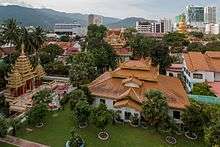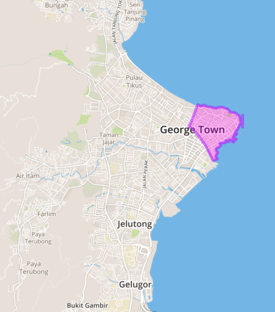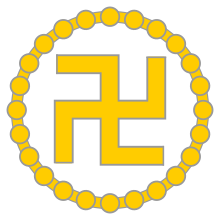Dhammikarama Burmese Temple
Dhammikarama Burmese Temple (Burmese: ဓမ္မိကာရာမမြန်မာကျောင်) is a Burmese temple in Pulau Tikus suburb of George Town of Penang in Malaysia. Situated in Burmah Road, the temple located close to the Wat Chayamangkalaram. It is the sole and oldest Malaysian Burmese temple in the state.[3] The temple also became a focal point for the annual Water, Songkran and Mid-Autumn festivals as well for Buddhist Lent and Candle Lighting Days within the city suburb.[4]
| Dhammikarama Burmese Temple ဓမ္မိကာရာမမြန်မာကျောင် | |
|---|---|
 The view of the temple compound | |
| Religion | |
| Affiliation | Buddhism |
| District | Northeast Penang Island District |
| Location | |
| Location | Pulau Tikus |
| State | Penang |
| Country | Malaysia |
 Shown within George Town | |
| Geographic coordinates | 5°25′51.345″N 100°18′51.347″E |
| Architecture | |
| Type | Burmese temple |
| Founder | U. Nandamala[1] |
| Date established | 1803[1][2][3][4] |
History
Since the early 19th century, there had been a Burmese settlement in Pulau Tikus.[1] On 1 August 1803, a small temple named "Nandy Moloh Temple" was erected in the area by the Burmese community from a land donated by Nyonya Betong after she purchased a land for $390 (Spanish dollar) from George Layton.[1][2][3][4] The first abbot for the temple is U. Nandamala.[1] Since its early times, women devotees have been the mainstay of the temple with four female trustees;[2] Nyonya Betong, Nyonya Meerut, Nyonya Koloh and Nyonya Bulan.[1] As the Burmese community grows, they later appeal to Queen Victoria for additional lands to extend the temple size as well for the burial grounds of the elders.[1] This was received positively by the government of the Straits Settlements and a grant was made to two Burmese female trustees named Nongmay and Boonkhan during the term of W. J. Butterworth as the Straits Settlements governor in 1845.[1][2][5]
Features
.jpg)
Established as a kyaung (monastery), the temple serves as a retreat for Buddhist devotee, with a monks' quarters, a preceptees' lodge and a library within the temple grounds. Numerous statues of the Buddha and mythical creatures such as elephants, fishes and the garuda to symbolise the "three realms of land, air and sea" are scattered within the temple,[2][4] including a pair of winged chimeras known as Panca Rupa (the Guardian Protectors of the World) and a huge mural depicting the Renunciation of the Buddha.[2][3][6] As with other Burmese temples, the chinthe is another prominent creature within the temple with the temple compound also featuring a gardening landscape.[6]
The oldest portion of the temple is its stupa, which was consecrated in 1805.[2] The stupa was then enshrined within an outer stupa that was built in 1838, along with the temple's Sasana Vamsa Sima Shrine Hall, which is guarded by a pair of stone elephants.[2][4][7] The shrine hall was last renovated in 1995 to cope with the increase in the number of devotees. The standing Buddha in the shrine hall has a gold-gilded backdrop of carvings with the hall ceiling also exhibits fine carvings which are lacquered brown.[4] In addition, a well was also dug for use by the surrounding Burmese community but since the advent of piped water, the well has since been left unused.[3]
The temple's Arahant Uppagupta Shrine was originally constructed in a wooden structure in 1840 before a new shrine is built in 1976.[7] Uppagupta is said to possess the power to ward evil spirits, obstacles and dangers.[8] The shrine is accompanied by two other statues; one of them are Arahant Khema.[7] Subsequently, a new structure called as the "Golden Pagoda Bell Tower" were added to the temple where it is completed in 2011 with a cost of RM3 million.[9][10] As with the rest of the temple, its pagoda is steeped in Burmese architectural styles, with artisans brought in from Myanmar specifically for the construction of the structure.[9]
 A monk standing in front of the temple gate.
A monk standing in front of the temple gate. The Panca Rupa winged chimeras (the Guardian Protectors of the World).
The Panca Rupa winged chimeras (the Guardian Protectors of the World). The temple stupas as seen in 2008.
The temple stupas as seen in 2008. Roofing arts with Burmese architecture.
Roofing arts with Burmese architecture..jpg) The Sima Shrine Hall.
The Sima Shrine Hall. Inside one of the temple hall.
Inside one of the temple hall.
References
- "The Early History of the Burmese Community in Penang". Penang Story. 5 January 2016. Archived from the original on 24 March 2019. Retrieved 24 March 2019.
Most of the early Burmese community were concentrated in the Burmese Village in Pulau Tikus. The original site of the temple land was purchased by Nonia Betong from George Layton for 390 Spanish dollars. The temple was founded on 1st August 1803 and named the Nandy Moloh Temple. The four trustees were all ladies: Nonia Betong, Nonia Meerut, Nonia Koloh and Nonia Bulan. The Burmese community expanded, and together with the Thai Buddhist community they appealed to Queen Victoria of England for land to build bigger temples and burial grounds for elders. Queen Victoria through the East India Company granted land jointly for the Siamese and Burmese communities to erect their temples. The Burmese Temple Trustees in 1845 were Nong May and Bon Khan.
- Khoo Salma Nasution (2007). Streets of George Town, Penang. Areca Books. p. 52–53. ISBN 978-983-9886-00-9.
- "A Tale of Three Temples – The Temples of Pulau Tikus". Penang Free Sheet. Archived from the original on 23 March 2019. Retrieved 24 March 2019.
Dhammikarama Burmese Temple, on Lorong Burma, is the only Burmese temple in Penang State, making it a unique to the State itself. First established in 1803, it is also the oldest Buddhist temple in Penang. In typical Burmese style, the temple complex is typified by traditional Burmese stupas, jutting above Pulau Tikus' shophouses and shining golden under Penang's blue skies. On first entering under the complex's ornate portico, a covered, open-air walkway leads you to the rear shrine. Lining this walkway is a huge mural depicting the Renunciation of Buddha, the story of how Buddha renounced his earthly desires while being plagued by tempting demons. The central gardens are filled with mythical creatures such as the chinthe, a lion-like guardian, and garudas, a humanoid bird prevalent in Buddhist and Hindu mythology. There is also a statue called 'Pance Rupa', comprised of two chimeras either side of a large globe. If you look closely you may be able to spot the three elements of land, air and sea in their bodies. The complex is an active Buddhist one, still capable of housing devotees and monks who have travelled to the temple. The complex comes with a monks' quarters, a preceptees' lodge and a library within the temple grounds. It also includes a well that was originally duy for use by the surrounding Burmese community; with the advent of piped water, the well has since been disused.
- "Buddhist temples in Penang". New Straits Times. 24 May 2018. Retrieved 24 March 2019 – via PressReader.
- Khoo Salma Nasution (2011). "Exploring Shared History, Preserving Shared Heritage: Penang's Links to a Siamese Past [The Siamese community and Buddhism in Penang]" (PDF). Journal of the Siam Society. Siamese Heritage. 100: 313 [10/15]. Archived from the original (PDF) on 23 March 2019. Retrieved 24 March 2019.
A Burmese temple was established there since the early nineteenth century. Around 1830, the Siamese and Burmese community totalled 648 out of a population of about forty thousand. In 1845, during the term of W. J. Butterworth as governor of the Straits Settlements, the East India Company made a grant of land to the Burmese and Siamese inhabitants to be jointly held by Nongmay and Boonkhan as representatives of the Burmese community, and Nankayo and Boonsoon as representatives of the Siamese community.
- Abhijeet Deshpande. "Dhammikarama Burmese Temple". Times of India. Retrieved 24 March 2019.
- "Dhammikarama Buddhist Temple". Malaysian Internet Resources. 2006. Archived from the original on 24 March 2019. Retrieved 24 March 2019.
- Andrew Walker (27 January 2013). "Upakhut in Malaysia". New Mandala. Archived from the original on 24 March 2019. Retrieved 24 March 2019.
- DK Travel (15 January 2016). DK Eyewitness Travel Guide Malaysia and Singapore. Dorling Kindersley Limited. p. 112. ISBN 978-0-241-25431-8.
- "Monk's vision realised". The Star. 16 May 2011. Retrieved 16 May 2017.
External links


